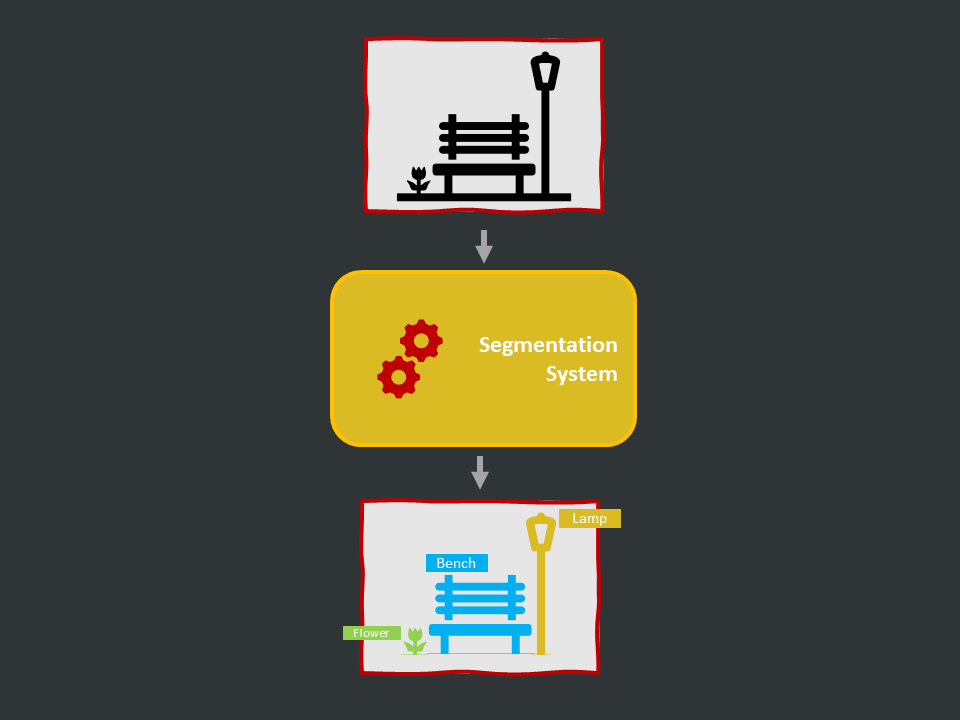Image Segmentation

Introduction
- Definition: Image segmentation is the task of assigning labels to each pixel of an image.
- Applications: Medical imaging, self-driving cars, satellite imaging
- Scope: Semantic and Instance masks, 2D pixel-mask, Real-time
- Tools: Detectron2, TFHub, TorchVision, DeepLab
Models
U-Net
U-Net: Convolutional Networks for Biomedical Image Segmentation. arXiv, 2015.
It was originally designed to perform medical image segmentation but it works well on a wide variety of tasks, from segmenting cells on microscope images to detecting ships or houses on photos taken from satellites.
Mask R-CNN
The Mask R-CNN framework is built on top of Faster R-CNN. ****So, for a given image, Mask R-CNN, in addition to the class label and bounding box coordinates for each object, will also return the object mask.
DeepLabV3+
Encoder-Decoder with Atrous Separable Convolution for Semantic Image Segmentation. arXiv, 2018.
It achieves a mean IOU score of 89% on the PASCAL VOC 2012 dataset.
Process flow
Step 1: Collect Images
Capture via camera, scrap from the internet or use public datasets
Step 2: Create Labels
This step is required only if the object category is not available in any pre-trained model or labels are not freely available on the web. To create the labels (pixel masks) using either open-source tools like Labelme or any other professional tool
Step 3: Data Acquisition
Setup the database connection and fetch the data into python environment
Step 4: Data Exploration
Explore the data, validate it and create preprocessing strategy
Step 5: Data Preparation
Clean the data and make it ready for modeling
Step 6: Model Building
Create the model architecture in python and perform a sanity check
Step 7: Model Training
Start the training process and track the progress and experiments
Step 8: Model Validation
Validate the final set of models and select/assemble the final model
Step 9: UAT Testing
Wrap the model inference engine in API for client testing
Step 10: Deployment
Deploy the model on cloud or edge as per the requirement
Step 11: Documentation
Prepare the documentation and transfer all assets to the client
Use Cases
Satellite Image Segmentation for Agricultural Fields
An image with 1800 x 1135 resolution and 60 channels. Every Month 5 bands images were shot from agricultural land for 12 months. There is 8 type of croplands. Task is to classify all unknown label pixels into one of these 8 categories. U-Net model was trained from scratch on patches. Checkout this notion.
Detectron2 Fine-tuning
Fine-tune Detectron2 Mask R-CNN (with PointRend) model on new classes. It supports semantic, instance, and panoptic segmentation. We fine-tuned on balloons, chipsets, and faces. Checkout this notion.
Industrial Use Cases for Image Segmentation
Experimented with 3 industrial use cases - Carvana Vehicle Image Masking, Airbus Ship Detection, and Severstal Steel Defect Detection. Checkout this notion.
Real-time segmentation on Videos
Real-time tracking and segmentation with SiamMask, semantic segmentation with LightNet++ and instance segmentation with YOLACT. Checkout this notion.
Image Segmentation Exercises
Thresholding with Otsu and Riddler–Calvard, Image segmentation with self-organizing maps, Random Walk segmentation with scikit-image, Skin color segmentation with the GMM–EM algorithm, Medical image segmentation, Deep semantic segmentation, Deep instance segmentation. Checkout this notion.
TorchVision Inference Experiments
FCN-ResNet and DeepLabV3 (both are available in TorchVision library) inference. Available as a streamlit app. Checkout this notion.